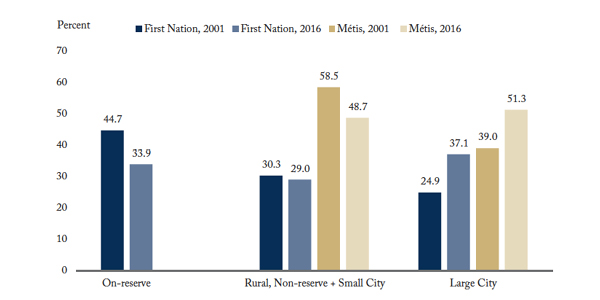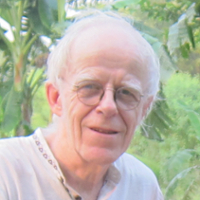
Reconciliation isn’t just about treaty rights
To grasp fully the context of reconciliation with Indigenous people in Canada, it’s important to understand that the choices of Indigenous people as where to live have changed over the past two decades. Doing so puts into clearer perspective the roles that federal and provincial governments need to play in a coordinated manner if real progress is to be made.
By John Richards, Professor of Public Policy, Simon Fraser UniversityDownload the JSGS Policy Brief
To grasp fully the context of reconciliation with Indigenous people in Canada, it’s important to understand that the choices of Indigenous people as where to live have changed over the past two decades. Doing so puts into clearer perspective the roles that federal and provincial governments need to play in a coordinated manner if real progress is to be made.
Based on Statistics Canada data, between the census of 2001 and the census of 2016, considerable rural-to-urban migration appears to have taken place across Canada among First Nation peoples. More recent results from the 2021 census are not yet available.
From 2001 to 2016, the share of those who identify as First Nation and live on-reserve declined by 11 percentage points, from 45 per cent to 34 per cent of the total. The share who live in rural, non-reserve and small cities remained more-or-less constant at 30 per cent, while the share living in a large city increased 12 points from 25 per cent to 37 per cent (see Figure 1). A similar migration has taken place among Métis. It must be stated that there is uncertainty in interpreting census data—questions such as who is First Nation, and since First Nation people experience high mobility, is home really on- or off-reserve? Despite these qualifications, one can reasonably conclude a net shift (from reserve to large cities) over 15 years of about 10 percentage points has taken place. Almost certainly, an important urbanizing trend is under way. This in turn raises an important question. Why this migration?

Probably, the best answers come from the large-scale survey of 2,600 urban Indigenous people (Métis and Inuit, as well as First Nation) undertaken for the Urban Aboriginal Peoples Study (UAPS). It was an effort to go beyond the numbers to identify the values, experiences and aspirations of Indigenous peoples living in Vancouver, Edmonton, Calgary, Regina, Saskatoon, Winnipeg, Thunder Bay, Toronto, Montreal, Halifax and Ottawa. It found that:
When asked (unprompted, without response options offered) why they first moved to their city, equal proportions cite the opportunity to be closer to family (38 per cent), and the pursuit of education (37 per cent) and employment opportunities (37 per cent). Smaller proportions say they moved to their city because it offered better amenities (18 per cent), the chance to escape a bad family situation (10 per cent) and the opportunity for career advancement (9 per cent). (Environics 2010, 32.)
In the context of today’s public policy environment, where the federal government has legitimately placed a high priority on reconciliation with First Nation peoples, the findings of the UAPS must be kept clearly in mind. The core of the federal government’s reconciliation strategy is to strengthen treaty rights and governing capacity of First Nation communities. With qualifications, this is a reasonable agenda for those wanting to live on-reserve. It is not, however, a reasonable agenda for those who live in a city or a rural off-reserve community—and who want reasonable employment opportunities at reasonable wages. At the core of successful reconciliation policy must be recognition that access to good jobs at good wages is inseparable from good education. Concerned by the apparent low priority attached to education success, six of us (educators, administrators, and academics) published an oped on this theme in fall 2021.1
Nowhere is an agenda of good jobs and better schools more important for First Nations than in the Prairies, in Manitoba and Saskatchewan in particular. What is the evidence?
Following each census, Indigenous Services Canada publishes a Community Well-Being Index (CWB), constructed for all First Nation and Inuit communities, and non-Indigenous communities. The CWB is a heroic attempt to summarize social conditions in more than 600 First Nation (and Inuit) communities in terms of employment, education, housing, and income. The national results show within the Indigenous population some stark and troubling regional variations in terms of employment.
From the first CWB index in 1981 to the most recent in 2016, the national First Nation employment rate has remained two-thirds the non-Indigenous rate. But since 1981, regional First Nation employment rates have diverged. Employment rates have risen more than 10 percentage points in the Atlantic region, Quebec, and the Territories, but rates have risen by less than 10 points in Ontario and BC. On the other hand, in the Prairies employment rates have stagnated, with 2016 rates the same as in 1981.2
According to the 2016 CWB, the average per capita income in First Nation communities across Canada was slightly below half that in non-Indigenous communities (see Table 1). Admittedly, correlation is not necessarily explanation. But the CWB reveals an undeniable association among education, employment and other factors of well-being. What it shows is exceptionally low First Nation employment rates in the Prairies, low CWB education index in the Prairies, and below average First Nation regional incomes in the Prairies. In a simple statistical exercise to estimate the impact of community employment and housing quality on community incomes in 400 First Nation communities across Canada, the low employment and low housing quality in Manitoba and Saskatchewan provide proximate explanations of exceptionally low incomes.
Table 1: Community Well-Being Index Average First Nation Income and Employment Rates, Canada and Regions, 2016
| Income | Employment Rate* | Education Index** | ||
| (Dollars) | Relative to non-Indigenous (Percent) | (Percent) | (Percent) | |
| Manitoba | 11,100 | 33.4 | 39.0 | 31.9 |
| Saskatchewan | 11,400 | 34.4 | 37.7 | 38.5 |
| Alberta | 15,500 | 46.8 | 41.4 | 32.8 |
| Canada | 15,800 | 47.8 | 47.4 | 40.2 |
| Ontario | 16,000 | 48.3 | 51.4 | 39.0 |
| Atlantic | 6,800 | 50.7 | 50.2 | 50.8 |
| British Columbia | 17,800 | 53.5 | 51.4 | 44.8 |
| Quebec | 19,400 | 58.4 | 52.6 | 53.7 |
| Territories | 30,100 | 90.8 | 58.5 | 42.0 |
| Canada, non-Indigenous communities | 33,200 | 100.0 | 70.5 | 55.6 |
| Source: author’s calculations from Community Well-Being Index; see Richards (2020a). | ||||
Notes:
*Employment rate is defined as percent employed ages 20-64.
**Education index includes percent ages 20 and above with at least secondary school plus percent ages 25 and above with a university degree. Two-third of weight is on secondary school, one-third on university.
Low education, low employment rate, and low wages are associated not only with low incomes. They are also associated with high rates of social pathologies. In 2015, the husband/wife team of Angus Deaton and Anne Case won the Nobel economics prize for their detailed analysis of prevalence of numerous morbidities and sources of distress in the U.S.: suicide, chronic joint pain, never married, not in the labour force, depression, alcohol and drug abuse. They make no claim to have a definitive explanation for these problems. However, they introduce persuasive evidence on the importance of declines post-1980 in wages and employment rates among men with education levels below a college degree. Many others have confirmed these conclusions (Wilson 1996; Case, Deaton 2020; Autor et al. 2018).
There are no studies in Canada as rigorous as those in U.S. linking social pathologies to low employment and low wages. However, there is Canadian evidence that conclusively links prevalence of social pathologies, such as those identified by Case/Deaton, to low employment and high poverty rates among First Nations. Personal, firsthand accounts provide compelling anecdotal evidence of these pathologies. One such account is that of Harold Johnson (2016). A long-time Crown prosecutor in northern Saskatchewan, Johnson provides a harrowing account of pathologies arising from Indigenous abuse of alcohol in his province. Another relevant source of evidence is the Statistics Canada reporting on homicides (see Table 2).
Table 2: Indigenous and non-Indigenous Homicide Victims, Canada and Selected Provinces, Average 2016-18
| Indigneous | Non-Indigenous | |||
| Count* | Rate** | Count* | Rate** | |
| Manitoba | 32.0 | 15.8 | 13.3 | 1.2 |
| Saskatchewan | 29.0 | 15.0 | 10.3 | 1.1 |
| Alberta | 34.0 | 12.7 | 60.3 | 1.5 |
| Canada | 146.0 | 8.6 | 434.0 | 1.2 |
| Canada, minus Prairies | 51 | 4.9 | 350.0 | 1.2 |
| Source: Statistics Canada. Homicide in Canada. various issues. Indigenous include both those identifying as First Nation and as Métis. | ||||
Notes:
*Average annual count, 2016-18
**Average annual rate among the relevant population. Annual rate is annual count per 100,000 in the relevant population.
Overall, Canadian homicide victim rates are much lower than in U.S., but this is not the case among the Prairie Indigenous population.3 Over the years 2016-18, a quarter of all homicide victims in Canada were Indigenous (First Nation or Métis). Three quarters are men. Among the majority of both Indigenous and non-Indigenous homicides, the victims and perpetrators are known to each other, as family members, friends, or associates.
Expressed as a rate per 100,000, the probability of being an Indigenous homicide victim outside the Prairies was four times that among the non-Indigenous (4.9 versus 1.2). In the Prairies, the probability of being an Indigenous homicide victim is nearly three times the probability of an Indigenous person outside the Prairies (15.8 in Manitoba, 15.0 in Saskatchewan, 12.7 in Alberta versus 4.9 elsewhere). Relative to non-Indigenous Canadians, the Prairie Indigenous homicide victim rate is 12 times the non-Indigenous rate. A similar pattern of very high Prairie Indigenous rates exists in the data on perpetrators of homicide (Richards 2020b). Finally, the pattern of exceptionally high Indigenous rates in the Prairies holds with respect to suicide (Kumar, Tjepkema 2019).
What’s to be done?
Using statistics to identify the public policy challenge is one thing. More difficult is finding solutions within the context of the reconciliation agenda. At one level it seems pretty obvious. The first task is to persuade First Nation leaders and politicians at the federal and provincial levels that higher employment and better education outcomes deserve a higher priority.
Doubtless, more can be done by federal and provincial governments in assuring First Nation employment options in private resource developments and government infrastructure projects across rural Canada. There is also some potential to decentralize government offices to northern regions. That said, for many living in remote First Nation communities with a low CWB score, out-migration is a reasonable choice. Recall the rationale underlying urban Indigenous trends in the Urban Aboriginal Peoples Study.
But without at least high-school certification, employment and income options are limited both on- and off-reserve. From an intergenerational perspective, better K-12 school outcomes are essential—as is post-secondary training. Order of Canada recipient Harvey McCue, who founded Trent University’s Indigenous Studies department, emphasizes that effective Indigenous education requires quality instruction in the core subjects of reading, math, and science. In addition, teachers must appreciate the Indigenous experience and be trained to work with Indigenous youth. For a variety of reasons, to succeed academically, Indigenous youth require on average more mentoring support than other students (McCue 2016). The fact is that some provinces are not adequately pursuing this responsibility, and Ottawa’s exclusive on-reserve focus has not helped.
The first provincial government in the Prairies to attempt a comprehensive reconciliation agenda was that of Allan Blakeney, premier of Saskatchewan in the 1970s. Among his initiatives were affirmative employment programs and the creation of Indigenous-dominated municipal governments in northern Saskatchewan. Given Blakeney’s engagement with Indigenous matters, Brian Mulroney appointed him to the Royal Commission of Aboriginal Peoples, which reported in 1996.
Blakeney’s view was that roughly a quarter of First Nation people truly want the lifestyle available on self-governing reserves, and that should be respected. Another quarter successfully engage in mainstream Canadian society. As for the half in the middle, they migrate between reserve and town and face many challenges in both contexts. During his travels across Canada with his fellow RCAP commissioners Blakeney eventually concluded the RCAP was not interested in concrete discussion about education and employment, key requirements for First Nation success in cities. His frustration was such that he finally resigned before the commission reported.
The attention devoted by the federal and provincial governments and First Nation leadership to the resolution of First Nation rights and powers is important. But it does little to address the needs of the majority of Indigenous people who live in Canada’s cities. Tragically, Blakeney’s critique is as relevant in the 2020s as in the 1990s.
If Canada is going to achieve its goal of reconciliation with Indigenous people it needs to put education at the centre of its agenda, for both First Nations people on-reserve and those who have migrated to cities and other communities in search of opportunity for a better life.
ISSN 2369-0224 (Print) ISSN 2369-0232 (Online)
Endnotes
1 Opinion: Reconciliation isn’t just about reserves (10 September 2021) is available at https://financialpost.com/opinion/opinion-reconciliation-isnt-just-about-reserves
2 For a more extensive review of the Community Well-Being Index, see Richards (2020a).
3 In 2020, the overall US homicide victim rate was 7.8 per 100,000. In 2008, per 100,000 the US black homicide victim rate was 19.6, a decline from nearly 40 in 1990. The comparable 2008 white rate was 3.3 (Cooper and Smith, 2011, p.11).
References
Autor, D., D. Dorn, G. Hanson. 2018. When Work Disappears: Manufacturing Decline and the Falling Marriage Value of Young Men. National Bureau of Economic Research.
Case, A., A. Deaton. 2020. Deaths of Despair and the Future of Capitalism. Princeton University Press.
Cooper, A. and E. Smith. 2011. Homicide Trends in the United States, 1980-2008. US Department of Justice.
Environics Institute. 2010. Urban Aboriginal Peoples Study. Available at https://www.uaps.ca/knowledge/reports/
Johnson, H. 2016. Firewater: How Alcohol is Killing My People (and Yours). University of Regina Press.
Kumar, M., M. Tjepkema. 2019. Suicide among First Nations people, Métis and Inuit (2011-2016): Findings from the 2011 Canadian Census Health and Environment Cohort.
McCue, H. (Waubageshig). 2016. First Nations Elementary-Secondary Education: A National Dilemma. Verbatim. C.D. Howe Institute.
Richards, J. 2018. Pursuing Reconciliation: The Case for an Off-Reserve Urban Agenda. Commentary 526. C.D. Howe Institute.
_______ 2020a. No Easy Answers: Insights into Community Well-being among First Nations. E-brief 304. C.D. Howe Institute.
_______ 2020b. First Nations Employment and Deaths of Despair. Inroads 49. available at https://inroadsjournal.ca/first-nations-employment-and-deaths-of-despair/
John Richards

A trained economist, John Richards has written extensively on social policy in Canada, primarily via the C.D. Howe Institute where he holds the Roger Phillips chair in social policy. His current social policy focus is on Aboriginal policy. He is also the co-editor of Inroads, a Canadian policy journal. A professor at Simon Fraser University’s School of Public Policy, Richards has taught and conducted research in Bangladesh over the last decade and heads a modest policy institute linked to the International University of Business Agriculture and Technology.

